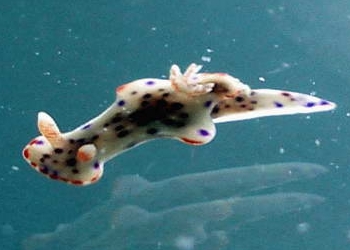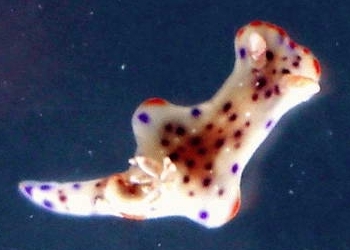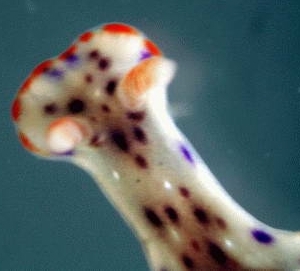Possible juvenile Ceratosoma?
August 20, 2007
From: Charles Raabe


Was unable to match this nudibranch and am curious as to what it could be. Thanks.
Locality: Mactan Island, Philippines, 25 feet, Camotes Sea, 15 August 2007, Crest of reef wall. Length: 5 mm. Photographer: Charles Raabe.
Charles Raabe
charlesr1958@pacific.net.ph
Raabe,C.A., 2007 (Aug 20) Possible juvenile Ceratosoma?. [Message in] Sea Slug Forum. Australian Museum, Sydney. Available from http://www.seaslugforum.net/find/20488
Dear Chuck,
It's definitely a juvenile Ceratosoma, and could be either Ceratosoma gracillimum or C. trilobatum. The complete absence of a mantle ridge between the frontal lobe and the gill lobes suggest it is C. gracillimum. I have never seen a specimen quite this small before and am amazed just how well-developed its body shape is.
I suggested some years ago that in Ceratosoma, the mantle glands filled with noxious chemicals were concentrated in specific 'sacificial' parts of the body, so that fish would be able to taste a non-essential part of the body and learn that the slug was distasteful without killing it. The most obvious parts are the characteristic dorsal horn and the lateral mantle lobes. In one species with a stumpy dorsal horn,Ceratosoma brevicaudatum, the dorsal horn is often bright red [see Fact Sheet photos], and acts as a lure attracting predators to the largest concentration of mantle glands. Recently a group of natural products chemists (Mollo et al, 2005) have shown the dorsal horn and lateral lobes of some tropical species are precisely where the anti-feedant chemicals are stored.
Your photo is very interesting becasue it shows bright red markings around the anterior mantle lobe and along the edge of the two lateral lobes precisely where the anti-feedant chemcials are stored, suggesting again that the colours are there to attract potential predators to the most distasteful part of the body. I can't see clearly, but it looks like there are red marks on the dorsal horn as well.
-
Mollo, E., Gavagnin, M., Carbone, M., Guo, Y.-W. & Cimino, G. (2005) Chemical studies on Indopacific Ceratosoma nudibranchs illuminate the protective role of the dorsal horn. Chemoecology, 15: 31-36.
-
Rudman, W.B. (1991) Purpose in Pattern: the evolution of colour in chromodorid nudibranchs. Journal of Molluscan Studies, 57, (T.E. Thompson Memorial Issue): 5-21.
Best wishes,
Bill Rudman
Related messages
-
Ceratosoma gracillimum from Alor, Indonesia
From: Francois Zylberman, April 24, 2008 -
Ceratosoma gracillimum feeding?
From: Kamal El Tawil, April 2, 2008 -
Ceratosoma gracillimum from Singapore
From: Lior Harari, September 3, 2007 -
Re: Ceratosoma gracillimum feeding? from Lembeh
From: Ken Tucker, July 23, 2007 -
Colour variations of Ceratosoma trilobatum?
From: Mike Krampf, December 22, 2006 -
Ceratosoma gracillimum? from Komodo Ids
From: Teresa Zubi, December 11, 2003 -
Ceratosoma gracillimum from north Sulawesi
From: Francis & Pirjo Pellet, December 10, 2003 -
Ceratosoma gracillimum from the Solomon Ids
From: Bruce Potter, November 29, 2001 -
Ceratosoma gracillimum from Japan
From: Atsushi Ono , September 19, 2000
